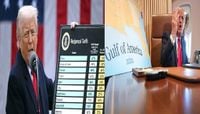When Donald Trump returned to the White House in 2025, the world braced for a foreign policy shift, but few anticipated just how dramatic—and, at times, erratic—that shift would be. According to Daniel W. Drezner’s analysis published in World Politics Review on November 4, 2025, Trump’s approach to global affairs in his second term can be best described not as a grand strategy, but as a "bunch of stuff"—a collection of impulsive, often contradictory moves driven by personal instincts, the agendas of close aides, and a transactional worldview.
This characterization isn’t just Drezner’s alone. As The New York Times’ David Sanger put it, "the only thing predictable about Mr. Trump’s handling of global affairs is that it will be an unpredictable mix of instinct, grievance and ego. And there is little evidence that his tantrums, swerves and reversals are strategic and thought-out, as his supporters sometimes insist, rather than the products of impulsivity, mood and circumstance."
But what does this mean in practice? The so-called "Trump 2.0 Doctrine," as examined by Firstpost and The Guardian, marks a sharp departure from the liberal institutionalism that has underpinned U.S. global leadership since 1945. Instead, it revives a style of expansionist, mercantilist, and often coercive foreign policy, where economic tools and territorial ambitions are wielded as primary instruments of power. Trump’s use of tariffs, for instance, has become a blunt force weapon—threatening Canada, Mexico, Japan, South Korea, and the European Union with punitive economic measures if they don’t fall in line with American interests.
In the Western Hemisphere, this approach has played out in ways both dramatic and, at times, bewildering. Treasury Secretary Scott Bessent, for example, directed U.S. bailout funds to Argentina to support President Javier Milei, a move that, as Drezner notes, seemed less about regional stability and more about benefitting hedge funds connected to Bessent’s friends. Meanwhile, Trump’s policy toward Venezuela has been shaped by the influence of figures like Marco Rubio and Stephen Miller, leading to a revival of "gunboat diplomacy" and the threat of military intervention under the guise of anti-drug trafficking operations.
Other actions have been even more overtly expansionist. Trump’s administration has floated the idea of renaming the Gulf of Mexico as the Gulf of America, a symbolic gesture that, for many in Mexico and the region, evokes memories of 19th-century U.S. territorial grabs. The ambitions don’t stop there: the Trump White House has openly mused about taking over the Panama Canal and threatened to withhold fiscal aid from Argentina if voters didn’t support the administration’s preferred outcomes in parliamentary elections.
According to Firstpost, these moves signal a return to a Monroe Doctrine-style focus on hemispheric dominance, but with a 21st-century twist: economic coercion and resource acquisition are now center stage. "Trump's rhetoric may sound theatrical, but it reflects a deeper hegemonic trend: the use of economic pressure and coercion as a substitute for direct military engagement," one commentator observed. The weakening of the World Trade Organization (WTO) further emboldens this approach, as global trade disputes become harder to adjudicate and countries are forced into bilateral deals with the U.S.
The unpredictability isn’t limited to the Americas. Across Europe, Trump has threatened tariffs on countries that impose digital taxes on U.S. tech giants, sparking fierce pushback from France and Germany, who insist on Europe’s right to regulate its own digital economy. Trump’s relationship with German Chancellor Olaf Scholz has been particularly fraught, with repeated threats and criticisms over defense spending, trade surpluses, and energy policy.
In Africa, Trump’s administration has cut all foreign aid, while threatening military action against Nigeria—ostensibly over religious violence, but with an eye, many believe, on the country’s oil reserves. Deals for mineral rights in the Democratic Republic of Congo and port agreements in Somalia have been pushed through, even as civil conflicts in Sudan and South Sudan are largely ignored.
Asia has seen its own share of Trump’s expansionist ambitions. The administration has demanded that U.S. overseas military bases in Japan and South Korea be converted into sovereign American territories, and has expressed a desire to reoccupy Bagram Air Base in Afghanistan. Crypto-currency deals with Pakistan and mineral rights agreements in Baluchistan further illustrate the transactional, resource-driven approach.
In West Asia, Trump has coordinated with Israel on military strikes against Iran, cut deals with Syrian figures, and secured a $400 million jet donation from Qatar. Perhaps most controversially, he’s pushed for his own family’s involvement in the redevelopment of Gaza, with visions of turning it into a "Mediterranean Riviera"—a move critics say is more about personal enrichment than peacebuilding.
For India, the Trump 2.0 era is a mixed bag. On the one hand, a more inward-looking U.S. could mean fewer pressures for military alignment. On the other, Washington’s new brand of economic coercion threatens India’s growing autonomy in technology, critical minerals, and energy. Secondary sanctions for buying Russian oil and continued development of the Chabahar port in Iran are just some of the challenges New Delhi faces.
Prime Minister Narendra Modi, addressing delegates from over 85 countries at India's Maritime Week (October 27–31, 2025), emphasized the need for strategic maritime cooperation and diversification of trade partnerships. As Modi put it, "the world is moving towards a new world order. The capability and the role of India are changing fast," according to NDTV. India’s External Affairs Minister, Dr. S. Jaishankar, echoed this sentiment, noting that "the course correction in American foreign policy was both expected and not necessarily disadvantageous for India as it hastens the advent of a multipolar world," as reported by Hindustan Times. He added, "the virtues of the old-world order are somewhat exaggerated," highlighting India’s readiness to adapt to a less rules-based, but more opportunity-rich, environment (Financial Times).
For now, the global community is left to navigate a U.S. foreign policy that is at once muscular, mercantilist, and unpredictable—a far cry from the carefully calibrated strategies of the past. As Drezner wryly observed, "when it comes to explaining Donald Trump’s foreign policy, believing that there is an overarching plan is a fool’s errand. It’s just a bunch of stuff that happened." In this new age of American expansionism, nations must be agile, pragmatic, and ready for anything.




